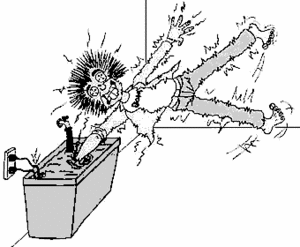One of the frequently overlooked considerations of a indoor growroom is electrical safety.
Although this topic covers many possible problems, the first one we will deal with is proper grounding.
Electrical Safety For Indoor Growrooms
Have you ever gotten a mild tingle or shock, while touching a metal reflector or other metal components in your growroom?
This is a result of little or no ground connection in your wiring.
Properly terminated connections will help prevent this from occurring, but the most important part of the wiring is a good ground connection.
Transient electrical currents can occur when a bare wire or terminal screw touches a metal component of your system.
Transient currents will travel through the path of least electrical resistance.
If you have proper ground connections <ground wire terminated to the metal part of component and the other end spliced to the ground of your three wire power supply> then the current will follow that path instead of going through your body as the resistance of your body is higher than the resistance of the ground wire.
Another consideration is water greatly reduces a body's resistance, so if you have water all over your floor or your hands and feet, then you are greatly increasing your chance of electrocution and possible death.
Safety Tips
1. Make sure that all electrical products are unplugged before servicing.
2. Keep all electrical wires off the floor and out of the way to avoid electrical shocks due to unwanted flooding or accidentally tripping over them.
3. The capacitor's used in high intensity lighting carry an electrical charge even after being unplugged.
Make sure to always use a rubber protection cap so not to accidentally touch the terminals.
4. When using multiple H I D lighting use a individually breakered timer panel to avoid over loading the main circuit and tripping the main breaker.
5. Do not put the ballast on anything flammable even if mounted in safety box.
The ballast generates high amount of heat and can easily cause a fire if they come into contact with combustibles.
6. Do not ever hang lights from their cords.
Always use a chain attached to the electrical box or reflector.
Hanging lights by the cord can cause connections to separate and short out.
7. When adjusting the time on an industrial timer always shut the power off before opening the timer.
From "maximum yield"
Electrocution prevention w/ GFCI's (Ground Fault Circuit Interrupter's) link
http://www.icmag.com/ic/showthread.php?t=4315

Various growroom-relative thread links (Electrical Equipment)
http://www.icmag.com/ic/showthread.php?t=15374
http://www.icmag.com/ic/showthread.php?t=13733
http://www.icmag.com/ic/showthread.php?t=13779
http://www.icmag.com/ic/showthread.php?t=4075
http://www.icmag.com/ic/showthread.php?t=6989
http://www.icmag.com/ic/showthread.php?t=4573
Although this topic covers many possible problems, the first one we will deal with is proper grounding.
Electrical Safety For Indoor Growrooms
Have you ever gotten a mild tingle or shock, while touching a metal reflector or other metal components in your growroom?
This is a result of little or no ground connection in your wiring.
Properly terminated connections will help prevent this from occurring, but the most important part of the wiring is a good ground connection.
Transient electrical currents can occur when a bare wire or terminal screw touches a metal component of your system.
Transient currents will travel through the path of least electrical resistance.
If you have proper ground connections <ground wire terminated to the metal part of component and the other end spliced to the ground of your three wire power supply> then the current will follow that path instead of going through your body as the resistance of your body is higher than the resistance of the ground wire.
Another consideration is water greatly reduces a body's resistance, so if you have water all over your floor or your hands and feet, then you are greatly increasing your chance of electrocution and possible death.
Safety Tips
1. Make sure that all electrical products are unplugged before servicing.
2. Keep all electrical wires off the floor and out of the way to avoid electrical shocks due to unwanted flooding or accidentally tripping over them.
3. The capacitor's used in high intensity lighting carry an electrical charge even after being unplugged.
Make sure to always use a rubber protection cap so not to accidentally touch the terminals.
4. When using multiple H I D lighting use a individually breakered timer panel to avoid over loading the main circuit and tripping the main breaker.
5. Do not put the ballast on anything flammable even if mounted in safety box.
The ballast generates high amount of heat and can easily cause a fire if they come into contact with combustibles.
6. Do not ever hang lights from their cords.
Always use a chain attached to the electrical box or reflector.
Hanging lights by the cord can cause connections to separate and short out.
7. When adjusting the time on an industrial timer always shut the power off before opening the timer.
From "maximum yield"
Electrocution prevention w/ GFCI's (Ground Fault Circuit Interrupter's) link
http://www.icmag.com/ic/showthread.php?t=4315

Various growroom-relative thread links (Electrical Equipment)
http://www.icmag.com/ic/showthread.php?t=15374
http://www.icmag.com/ic/showthread.php?t=13733
http://www.icmag.com/ic/showthread.php?t=13779
http://www.icmag.com/ic/showthread.php?t=4075
http://www.icmag.com/ic/showthread.php?t=6989
http://www.icmag.com/ic/showthread.php?t=4573
Last edited:





